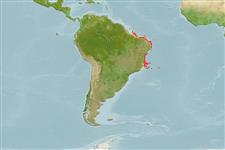Teleostei (teleosts) >
Blenniiformes (Blennies) >
Blenniidae (Combtooth blennies) > Salariinae
Etymology: Hypleurochilus: Greek, hypo = under + Greek, pleura = in the side of + Greek, cheilos = lip; brasil: Named after the vivid red spots, similar to incandescent pieces of a brazing; Brazil’s country name (Brasil in Portuguese), where the species is endemic, originally has a similar derivation (name given in recognition of the reddish colour of the wood of a large Brazilian native tree - Caesalpinia echinata, 'Pau-Brasil' in Portuguese); noun in apposition..
Environment: milieu / climate zone / depth range / distribution range
Ecology
Marine; reef-associated; depth range 3 - 15 m (Ref. 94079). Tropical
Western Atlantic: Brazil (Trindade Island and Martin Vaz).
Size / Weight / Age
Maturity: Lm ? range ? - ? cm
Max length : 3.1 cm SL male/unsexed; (Ref. 94079); 2.7 cm SL (female)
Short description
Morphology | Morphometrics
Dorsal
spines
(total): 12;
Dorsal
soft rays
(total): 13-14;
Anal
spines: 2;
Anal
soft rays: 15 - 16;
Vertebrae: 36. This species is distinguished from its congeners by the following set of characters: pelvic-fin rays I, 3, dorsal fin usually XII,13, anal fin II,15-16 (usually 16), no blackened stripes, nape green or white and presence of numerous tiny red spots along body, diminishing in size posteriorly (Ref. 94079).
Found either solitary or in small groups of up to 10 individuals; in small holes or associated with sea-urchins and sponges on the rocky reefs (Ref. 94079). Oviparous. Eggs are demersal and adhesive (Ref. 205), and are attached to the substrate via a filamentous, adhesive pad or pedestal (Ref. 94114). Larvae are planktonic, often found in shallow, coastal waters (Ref. 94114).
Life cycle and mating behavior
Maturity | Reproduction | Spawning | Eggs | Fecundity | Larvae
Pinheiro, H.T., J.L. Gasparini and C.A. Rangel, 2013. A new species of the genus Hypleurochilus (Teleostei: Blenniidae) from Trindade Island and Martin Vaz Archipelago, Brazil. Zootaxa 3709(1):95-100. (Ref. 94079)
IUCN Red List Status (Ref. 130435)
Threat to humans
Harmless
Human uses
More information
Common namesSynonymsMetabolismPredatorsEcotoxicologyReproductionMaturitySpawningSpawning aggregationFecundityEggsEgg development
Age/SizeGrowthLength-weightLength-lengthLength-frequenciesMorphometricsMorphologyLarvaeLarval dynamicsRecruitmentAbundanceBRUVS
ReferencesAquacultureAquaculture profileStrainsGeneticsElectrophoresesHeritabilityDiseasesProcessingNutrientsMass conversion
Tools
Warning: mysqli::__construct(): (08004/1040): Too many connections in /var/www/html/includes/speciessummary.lib.php on line 2414
Can't connect to MySQL database fbquizv2. Errorcode: Too many connections
